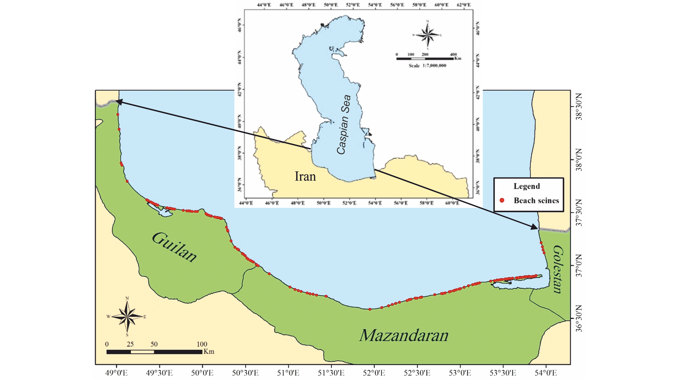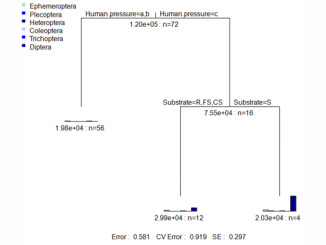
Paper category: Original research paper
Corresponding author: Hasan Fazli (hn_fazli@yahoo.com)
DOI: https://doi.org/10.26881/oahs-2022.1.08
Received: 03/05/2021
Accepted: 16/08/2021
Full text: here
Citation (APA style): Fazli,H.,Kaymaram,F. & Daryanabard,G.(2022).Effects of fishing and environmental parameters on the commercial bony fish assemblage in the southern Caspian Sea. Oceanological and Hydrobiological Studies,51(1) 90-99. https://doi.org/10.26881/oahs.2022.1.08
Abstract
Since the 1990s, anthropogenic activities have been the major direct or indirect threats to the structural and functional organization of the unique ecosystem of the Caspian Sea (CS). This study attempts to investigate the relationships between fish community structure and environmental parameters and to analyze the Abundance Biomass Comparison (ABC) in the CS. The input data, including catch data by species and environmental parameters, were collected from 1996 to 2017. Of the 13 bony fish species identified, only two species Rutilus kutum and Chelon aurata accounted for 47.14% and 62.65%, and 40.80% and 29.34% of CPUE and NPUE, respectively. DisTLM revealed that five environmental variables showed a significant linear relationship with the NPUE resemblance matrix. Based on the AIC criteria, the combination of year, precipitation, SST_Apr, SSL, SST, GTA, Iranian rivers, and Volga discharges explain 80.3% of the total variability. Based on the ABC curves and W statistics, it was concluded that the fish assemblage was environmentally stressed from 1996 to 2003. The Shannon diversity index (H´) showed a decreasing trend, suggesting that fish species have been exposed to increasing stress over the past 22 years. Considering the current environmental conditions (downward trend in SSL river discharge and increase in SST) and anthropogenic activities, it appears that the downward trend will continue in the future.
References
Anderson, M. J., Gorley, R. N., & Clarke, K. R. (2008). PERMANOVA+for PRIMER: Guide to Software and Statistical Methods. PRIMER-E.
Arpe, K., Bengtsson, L., Golitsyn, G. S., Mokhov, I. I., Semenov, V. A., & Sporyshev, P. V. (2000). Connection between Caspian Sea level variability and ENSO. Geophysical Research Letters, 27(17), 2693–2696. https://doi.org/10.1029/1999GL002374
Ataei, H. S., Jabari, Kh. A., Khakpour, A. M., Neshaei, S. A., & Yosefi Kebria, D. (2019). Long-term Caspian Sea level variations based on the ERA-interim model and rivers discharge. International Journal of River Basin Management, 17(4), 507–516. https://doi.org/10.1080/15715124.2018.1546730
Beyraghdar Kashkooli, O., Gröger, J. & Núñez-Riboni, I. (2017). Qualitative assessment of climate-driven ecological shifts in the Caspian Sea. PLoS ONE. 12, 5, e0176892. https://doi.org/10.1371/journal.pone.0176892
Blanchard, F., LeLoc’h, F., Hily, C., & Boucher, J. (2004). Fishing effects on diversity, size and community structure of the benthic invertebrate and fish megafauna on the Bay of Biscay coast of France. Marine Ecology Progress Series, 280, 249–260. https://doi.org/10.3354/meps280249
Clarke, K. R., & Gorley, R. N. (2006). PRIMER version 6: user manual/tutorial. PRIMER-E.
Clarke, K. R., & Warwick, R. M. (2001). Change in marine communities: An approach to Statistical Analysis and Interpretation (2nd ed.). PRIMER-E.
Daryanabard, G. R., Fazli, H. & Parafkandeh Haghighi, F. (2016). Relative abundance of kutum (Rutilus kutum) in beach seines of the Caspian Sea. Iranian Scientific Fisheries Journal 24(4): 145-155 (In Farsi).
Escobar-Toledo, F., Zetina-Rejón, M. J., & Duarte, L. O. (2015). Measuring the spatial and seasonal variability of community structure and diversity of fish by-catch from tropical shrimp trawling in the Colombian Caribbean Sea. Marine Biology Research, 11(5), 528–539. https://doi.org/10.1080/17451000.2014.952311
Fazli, H., Daryanabard, G. R., Abdolmaleki, S., & Bandani, G. A. (2013). Stock assessment and management implications of golden grey mullet (Liza aurata Risso, 1810) in Iranian waters of the Caspian Sea. Journal of Applied Ichthyology, 29(2), 431–436. https://doi.org/10.1111/jai.12003
Fazli, H., Janbaz, A. A., & Khedmati, K. (2020). Risk of stock extinction of two species of kilkas (Clupeonella engrauliformis and C. grimmi) in the Caspian Sea. Iranian Journal of Ichthyology, 7(1), 92–100. https://doi.org/10.22034/iji.v7i1.371
Fazli, H., Daryanabard, G. R., Salmanmahiny, A., Abdolmaleki, S., Bandani, G., & Afraei Bandpei, M. A. (2012). Fingerling release program, biomass trend and evolution of the condition factor of Caspian kutum during the 1991–2011 period. Cybium, 36(4), 545–550. https://doi.org/10.26028/cybium/2012-364-007
Fazli, H., Tavakoli, M., Behrouz Khoshghalb, M. R., & Moghim, M. (2021). Population dynamics of stellate sturgeon Acipenser stellatus Pallas, 1771 in the southern Caspian Sea. Iranian Journal of Fisheries Science, 20(1), 45–61. https://doi.org/10.22092/ijfs.2021.123469
Froese, R., & Pauly, D. (Eds.). (2019). FishBase. World Wide Web electronic publication. www.fishbase.org, version (12/2019).
Garcia, S. M. (2003). The ecosystem approach to fisheries. Issues, terminology, principles, institutional foundations, implementation and outlook. Fisheries Technical Paper, No. 443. FAO.
Haghi Vayghan, A., Zarkami, R., Sadeghi, R., & Fazli, H. (2016). Modeling habitat preferences of Caspian kutum, Rutilus frisii kutum (Kamensky, 1901) (Actinopterygii, Cypriniformes) in the Caspian Sea. Hydrobiologia, 766(1), 103–119. https://doi.org/10.1007/s10750-015-2446-3
Haghi Vayghan, A., Poorbagher, H., Taheri Shahraiyni, H., Fazli, H., & Nasrollahzadeh Saravi, H. (2013). Suitability indices and habitat suitability index model of Caspian kutum (Rutilus frisii kutum) in the southern Caspian Sea. Aquatic Ecology, 47(4), 441–451. https://doi.org/10.1007/s10452-013-9457-9
Hermosilla, C., Rocha, F., & Valavanis, V. (2011). Assessing Octopus vulgaris distribution using presence-only model methods. Hydrobiologia, 670(1), 35–47. https://doi.org/10.1007/s10750-011-0671-y
Johnson, J. E., & Welch, D. J. (2009). Marine fisheries management in a changing climate: A review of vulnerability and future options. Reviews in Fisheries Science, 18(1), 106–124. https://doi.org/10.1080/10641260903434557
Katsanevakis, S., Maravelias, C. D., Damalas, D., Karageorgis, A. P., Tsitsika, E. V., Anagnostou, C., & Papaconstantinou, C. (2009). Spatiotemporal distribution and habitat use of commercial demersal species in the eastern Mediterranean Sea. Fisheries Oceanography, 18(6), 439–457. https://doi.org/10.1111/j.1365-2419.2009.00523.x
Khodorevskaya, R. P., Rudan, G. I., & Pavlov, D. S. (2009). Behavior, migrations, distribution, and stocks of sturgeons in the Volga-Caspian basin. Wulmstorf.
Khodorevskaya, R., Kim, Y., Shahifar, R., Mammadov, E., Katunin, D., Morozov, B., Akhundov, M., Muradov, O., & Velkova, V. (2014). State and dynamics of the bioresources in the Caspian Sea. In D. Barcelo & A. G. Kostianoy (Eds.), The Handbook of Environmental Chemistry (pp. 1–84). Springer.
Mise, F. T., Message, H. J., Pagotto, J. P. A., & Goulart, E. (2018). Environmental assessment in tropical streams by using abundance-biomass curves and W index in fish assemblages. Iheringia. Série Zoologia, 108, 1–9. https://doi.org/10.1590/1678-4766e2018029
Mouton, A. M., Schneider, M., Depestele, J., Goethals, P. L. M., & De Pauw, N. (2007). Fish habitat modeling as a tool for river management. Ecological Engineering, 29(3), 305–315. https://doi.org/10.1016/j.ecoleng.2006.11.002
Naseka, A. M., & Bogutskaya, N. G. (2009). Fishes of the Caspian Sea: Zoogeography and updated check-list. Zoosystematica Rossica, 18(2), 295–317. https://doi.org/10.31610/zsr/2009.18.2.295
Pikitch, E. K., Santora, C., Babcock, E. A., Bakun, A., Bonfil, R., Conover, D. O., Dayton, P., Doukakis, P., Fluharty, D., Heneman, B., Houde, E. D., Link, J., Livingston, P. A., Mangel, M., McAllister, M. K., Pope, J., & Sainsbury, K. J. (2004). Ecology. Ecosystem-based fishery management. Science, 305, 346–347. https://doi.org/10.1126/science.1098222 PMID:15256658
Pourang, N., Eslami, F., Nasrollahzadeh Saravi, H., & Fazli, H. (2016). Strong biopollution in the southern Caspian Sea: The comb jelly Mnemiopsis leidyi case study. Biological Invasions, 18(8), 2403–2414. https://doi.org/10.1007/s10530-016-1171-9
Qiwei, W. (2010). Acipenser stellatus. The IUCN Red List of Threatened Species 2010: e.T229A13040387. https://doi.org/10.2305/IUCN.UK.2010-1.RLTS.T229A13040387.en. Downloaded on 18 January 2018.
Roohi, A., Kideys, A. E., Sajjadi, A., Hashemian, A., Pourgholam, R., Fazli, H., Khanari, A. G., & Eker-Develi, E. (2010). Changes in biodiversity of phytoplankton, zooplankton, fishes and macrobenthos in the Southern Caspian Sea after the invasion of the ctenophore Mnemiopsis leidyi. Biological Invasions, 12(7), 2343–2361. https://doi.org/10.1007/s10530-009-9648-4
Sparre, P., & Venema, S. C. (1998). Introduction to tropical fish stock assessment. FAO Fisheries Technical Paper.
Suleymanov, S. S., Azizov, A. P., & Ghassemi, H. (2015). The species composition and nutrition of dominant species of fish of Absheron Gulfs of the Caspian Sea. Iranian Journal of Fisheries Science, 14(2), 513–522.
Tavakoli, M., Fazli, H., Moghim, M., Khoshghalb, M. R. B., Valinasab, T., & Abdolmaleki, S. (2019). Population ecological parameters and stock assessment of Russian sturgeon Acipenser gueldenstaedti Brandt and Ratzeburg, 1833 in the Southern Caspian Sea. Journal of Applied Ichthyology, 35(1), 378–386. https://doi.org/10.1111/jai.13730
Thrush, S. F., & Dayton, P. K. (2010). What can ecology contribute to ecosystem-based management? Annual Review of Marine Science, 2(1), 419–441. https://doi.org/10.1146/annurev-marine-120308-081129 PMID:21141671
Warwick, R. M., & Clarke, K. R. (1994). Relearning the ABC: Taxonomic changes and abundance/biomass relationships in disturbed benthic communities. Marine Biology, 118(4), 739–744. https://doi.org/10.1007/BF00347523
Yemane, D., Field, J. G., & Leslie, R. W. (2005). Exploring the effects of fishing on fish assemblages using Abundance Biomass Comparison (ABC) curves. ICES Journal of Marine Science, 62(3), 374–379. https://doi.org/10.1016/j.icesjms.2005.01.009

